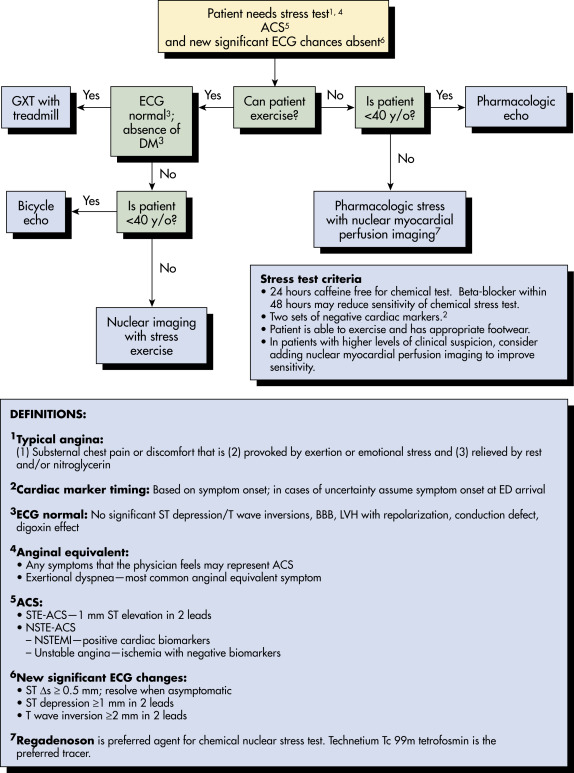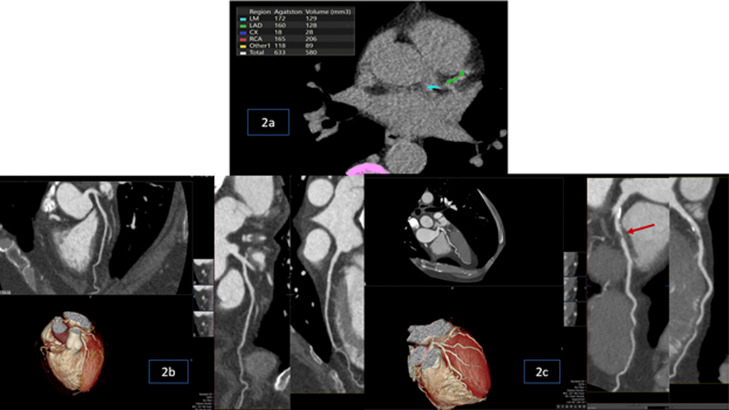AUTHOR: Maheswara Satya Gangadhara Rao Golla, MD
Angina pectoris is a term used to describe a clinical syndrome, typically characterized by chest, jaw, shoulder, back, or arm discomfort that is caused by myocardial ischemia. This is most commonly related to atheromatous plaque in one or more than one large epicardial coronary artery; however, myocardial ischemia may occur in the absence of obstructive coronary artery disease (CAD), such as uncontrolled hypertension, microvascular disease, valvular heart disease, hypertrophic cardiomyopathy, coronary spasm, or endothelial dysfunction. Any situation that causes an imbalance in myocardial oxygen supply and demand can cause an angina syndrome. Angina can be classified as follows:
- Chronic stable angina, stable ischemic heart disease (SIHD), or chronic CAD:
- Predictable. Usually follows a precipitating event (e.g., climbing stairs, sexual intercourse, a heavy meal, emotional stress, cold weather)
- Generally, has the same severity as previous attacks; relieved by rest or by the customary dose of sublingual nitroglycerin
- Caused by a fixed coronary artery obstruction secondary to atherosclerosis. The presence of one or more obstructions in major coronary arteries is likely; the severity of stenosis is usually >70%
- Unstable (rest, recent onset, crescendo angina; will be reviewed under “Acute Coronary Syndrome”):
- Rest angina: Angina occurring at rest and usually prolonged >20 min, occurring within 1 wk of presentation
- Recent onset: Angina of at least CCS Class III severity occurring less than 2 mo after the onset of the symptoms
- Crescendo angina: Previously diagnosed angina that is distinctly more frequent, longer in duration, or lower in threshold (i.e., increased by >1 CCS class within 2 mo of initial presentation to at least CCS Class III severity)
- Prinzmetal variant:
- Occurs at rest, common after cold exposure
- Cyclical in nature
- ECG finding of episodic ST-segment elevations
- Caused by coronary artery spasm with or without superimposed CAD
- Patients are more likely to develop ventricular arrhythmias
- Microvascular angina (syndrome X):
- Refers to patients with angina symptoms, positive exercise test, normal coronary angiograms, and no coronary spasm. Defective endothelium-dependent dilation in the coronary microcirculation contributes to the altered regulation of myocardial perfusion and the ischemic manifestations in these patients.
- Patients with chest pain and normal or nonobstructive coronary angiograms are predominantly women, and many have a prognosis that is not as benign as commonly thought (2% risk of death or myocardial infarction [MI] at 30 days of follow-up).
- Refractory angina:
- Refers to patients who, despite optimal medical therapy with at least maximal doses, or as tolerated of two antianginal medications, in addition to aspirin, aggressive risk factor modification, such as smoking cessation, adequate control of hypertension, diabetes, and hyperlipidemia, still have both angina and objective evidence of ischemia
- Other:
- Angina due to aortic stenosis and idiopathic hypertrophic subaortic stenosis, cocaine-induced coronary vasoconstriction
Stable angina should be classified using a grading system. The most commonly adopted is that of the Canadian Cardiovascular Society (CCS):
- Class I: Ordinary physical activity, such as walking or climbing stairs, does not cause angina. Angina occurs with strenuous, rapid, or prolonged exertion at work or recreation.
- Class II: Slight limitation of ordinary activity. Angina occurs on walking or climbing stairs rapidly; walking uphill; walking or stair climbing after meals, in cold, in wind, or under emotional stress; or only during the few hours after awakening. Angina occurs on walking more than two level blocks and climbing more than one flight of ordinary stairs at a normal pace and in normal conditions.
- Class III: Marked limitations of ordinary physical activity. Angina occurs on walking one to two level blocks and climbing one flight of stairs in normal conditions and at a normal pace.
- Class IV: Inability to carry on any physical activity without discomfort; anginal symptoms may be present at rest.
| ||||||||||||||||||||||||||||||||||||||||||||||||||||
- It is estimated that one in three adults in the U.S. (about 81 million) has some form of cardiovascular disease. Based on the NHANES survey 2007 to 2010, an estimated 15.4 million have coronary heart disease (CHD) of which 7.8 million have angina.
- Angina is most common in middle-aged and elderly men. Among persons 60 to 79 yr of age, approximately 25% of men and 16% of women have CHD, and these figures rise to 37% and 23% among men and women >80 yr of age, respectively.
- The incidence of CHD and angina in women after menopause is similar to that of men.
- Although the survival rate has steadily improved over time, SIHD remains the number one cause of death in men and women (27% of deaths).
- The initial manifestation of ischemic heart disease is angina pectoris in 50%, and about 50% of patients presenting to the hospital with acute coronary syndrome have preceding angina.
- Two older population-based studies from Olmstead County, MN, and Framingham, MA, showed annual rate of MI in patients with symptomatic angina of 3% to 3.5%/yr.
- Within 12 mo of initial diagnosis, 10% to 20% of patients with diagnosis of stable angina progress to MI or unstable angina.
- The assessment of chest pain should include quality, location, severity, and duration of pain; radiation; associated symptoms; provocative factors; and alleviating factors. Anginal pain can be described as “squeezing,” “griplike,” “suffocating,” and “heavy,” but it is rarely sharp or stabbing and typically does not vary with position or respiration. The classic Levine sign is placing a clenched fist over the precordium to describe the pain. Many patients do not, however, describe angina as frank pain but as tightness, pressure, or discomfort. Other patients, in particular women and older adults, can present with atypical symptoms such as nausea, vomiting, midepigastric discomfort, sharp (atypical) chest pain, dizziness, or syncope.
- Ischemic pain of more than 20 minutes’ duration should raise concern for possible acute coronary syndrome.
- Women are more likely than men to report atypical chest pain or discomfort (65% reported on Women’s Ischemic Syndrome Evaluation [WISE] study).
- Elderly and diabetics may report symptoms other than chest pain, such as dyspnea, fatigue, or diaphoresis.
- Advanced age.
- Male sex.
- Genetic predisposition, family history of premature CAD in first-degree relatives (men <55 yr of age, and women <65 yr of age).
- Smoking (risk of first MI is increased by near threefold).
- Hypertension.
- Hyperlipidemia.
- Impaired glucose tolerance or diabetes mellitus.
- History of stroke or peripheral arterial disease.
- Chronic kidney disease (CKD).
- Metabolic syndrome.
- Physical inactivity.
- Obesity (body mass index [BMI] >30% over ideal). A higher BMI during childhood is also associated with an increased risk of CHD in adulthood.
- Entities that cause increased oxygen demand include hyperthermia (particularly if accompanied by volume contraction), hyperthyroidism, and cocaine or methamphetamine abuse.
- Cocaine is used by >5 million Americans regularly and is responsible for >64,000 emergency department (ED) evaluations yearly to rule out myocardial ischemia. Cocaine causes sympathomimetic toxicity and not only increases myocardial oxygen demand but also induces coronary vasospasm and can cause infarction in young patients. Long-term cocaine use can cause premature development of SIHD.
- Severe uncontrolled hypertension causes increased myocardial oxygen demand and decreased subendocardial perfusion that increases left ventricular (LV) wall tension. Hypertrophic cardiomyopathy and aortic stenosis can induce even more severe LV hypertrophy and resultant wall tension.
- Other causes of increased myocardial oxygen demand are ventricular or supraventricular tachycardias. Ambulatory monitoring may be required to diagnose these.
- Entities that limit myocardial oxygen supply such as anemia may cause angina when the hemoglobin drops to <9 g/dl, and ST-T-wave changes (depression or inversion) can occur at levels <7 g/dl.
- Hypoxemia resulting from pulmonary disease (e.g., pneumonia, asthma, chronic obstructive pulmonary disease, pulmonary hypertension, interstitial fibrosis, or obstructive sleep apnea) can also precipitate angina.
- Polycythemia, leukemia, thrombocytosis, and hypergammaglobulinemia.
- Oral contraceptive and hormone replacement therapy use.
- Coronary artery calcium is associated with an increased risk of MI.
- Long-term use of NSAIDs.
- Exposure to air pollution from traffic (dilute diesel exhaust) promotes myocardial ischemia and is associated with adverse cardiovascular events.
- Low serum folate levels required for conversion of homocysteine to methionine are associated with an increased risk of fatal CHD. Hyperhomocysteinemia has a toxic effect on vascular endothelium and interferes with proliferation of arterial wall smooth muscle cells. Elevated plasma homocysteine level is a strong and independent risk factor for CHD events, especially in patients with type 2 diabetes mellitus.
- Elevated levels of highly sensitive C-reactive protein (hs-CRP, cardio CRP). Diseases associated with systemic inflammation can lead to accelerated atherosclerosis.
- Depression.
- Vasculitis.
- Elevated levels of lipoprotein-associated phospholipase A2.
- Elevated fibrinogen levels.
- Low level of red blood cell glutathione peroxidase-1 activity.
- Radiation therapy.




